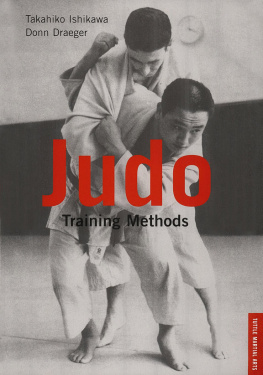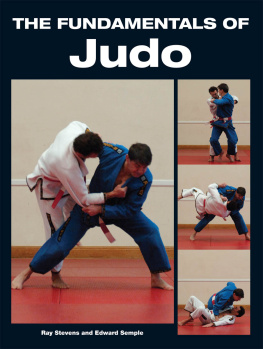Disclaimer
Please note that the authors and publisher of this book are not responsible in any manner whatsoever for any injury that may result from practicing the techniques and/or following the instructions given within. Since the physical activities described herein may be too strenuous in nature for some readers to engage in safely, it is essential that a physician be consulted prior to training.
All Rights Reserved
No part of this publication, including illustrations, may be reproduced or utilized in any form or by any means, electronic or mechanical, including photocopying, recording, or by any information storage and retrieval system (beyond that copying permitted by sections 107 and 108 of the US Copyright Law and except by reviewers for the public press), without written permission from Via Media Publishing Company.
Warning: Any unauthorized act in relation to a copyright work may result in both a civil claim for damages and criminal prosecution.
Copyright 2016
by Via Media Publishing Company
941 Calle Mejia #822, Santa Fe, NM 87501 USA
All articles in this anthology were originally
published in the Journal of Asian Martial Arts.
Listed according to the table of contents for this anthology:
Smith R.W. (1996), Vol. 5 No. 3, pp. 60-65
Jones, L. (2005), Vol. 14, No. 3, pp. 72-85
Ebell, S.B. (2008), Vol. 17, No. 1, pp. 28-37
Gatling, L. (2008), Vol. 17 No. 1, pp. 68-77
Jones, L., & Hanon, M. (2010), Vol. 19 No. 4, pp. 8-37
Yiannakis, L. (2011), Vol. 20 No. 3, pp. 92-107
Yiannakis, L. (2014), Vol. 23, pp. 1-13
Jones, J., Savage, M. & Gatling, L. (2014), Vol. 25, pp. 1-45
Jones, L. (2016), In Asian Martial Arts:
Constructive Thoughts & Practical Applications, pp. 86-89
Book and cover design by
Via Media Publishing Company
Edited by
Michael A. DeMarco, M.A.
Cover illustration
Jigoro Kano (right) with his gifted protg Kyuzo Mifune.
ISBN: 9781893765351
ISBN-13: 9781893765726 eBook
www.viamediapublishing.com
contents
by Michael DeMarco, M.A.
CHAPTERS
by Robert W. Smith, M.A.
by Llyr C. Jones, Ph.D.
by S. Biron Ebell, M.A.
by W. Lance Gatling, M.A., M.P.S.
by Llyr C. Jones, Ph.D., and Michael J. Hanon, Ph.D.
by Linda Yiannakis, M.S.
by Linda Yiannakis, M.S.
by Llyr C. Jones, Ph.D, Martin P. Savage, B.Ed., and W. Lance Gatling, M.A., M.P.S.
by Llyr C. Jones, Ph.D.
The practice of judo katas has changed over time as a result of perceived purpose. The chapters in this anthology were written by seven authorities in judo history and practice. Their writings clarify the purpose of kata and thus its mode of practice and their place in competition.
In 1926, a contest occurred in which thirty-seven of the finest judoka in Japan competed before the Emperor Hirohito. The first chapter by Robert W. Smith details the techniques utilized by each master and also compares their skills with todays judo practitioners.
The next two chapters by Dr. Llyr Jones and Biron Ebell deal with the transmutation of judo over the decades. Both authors give ample support that the original guidelines have evolved into competitive sport resulting in a substantial decline in the number of adults practicing judo.
Where does kata stand in judo practice today? Dr. Lance Gatling reports on The First Kodokan Judo International Competition (2007). He outlines the background of the competition, the competitors, the motivations for this competition, the historical development of judo katas, and their importance to the correct study of judo.
Dr. Llyr Jones next chapter has two objectives: to explain the purpose of kata in judo, and to critically evaluate the concept of kata championships. To achieve these objectives, Jones offers personal comments, observations from rare Japanese source material, as well as insight into the thinking of world-renowned judo experts.
Linda Yiannakis provides two insightful chapters. Her first chapter presents a conceptual framework for examining principles of judo throwing techniques. The principles are classified as primarily structural, operational, or contextual in nature. In her second chapter, she points out that martial artists are acutely aware of the need to develop a sense of timing for the best possible moment to apply techniques in free play or contest. This chapter examines some critical features of patterns and rhythms in a variety of contexts and provides a few basic exercises for the development of awareness and use of rhythm, patterns, and timing in judo.
Jones, Savage, and Gatling present an in-depth study into Kodokan Goshin-jutsua Kodokan judo exercise formally established in 1956 to teach the principles and techniques of self-defense against unarmed and armed attacks, and to meet modern lifestyle needs. Their chapter reviews the place of Goshin-jutsu among the Kodokan katas, and then summarizes the history its creation. A description of the exercises structure and technical contents follows, along with an in-depth explanation of its principles and associated teaching and learning challenges. This also includes a review of the most reliable learning texts in Japanese, English and selected other Western languages.
Kodokan Goshin-jutsus performance aspects are considered next. An objective assessment of its practical self-defense effectiveness follows, before finally conclusions are drawn.
The short final chapter by Dr. Jones is on Kodokan judos Nage-no-kata (forms of throwing) and Katame-no-kata (forms of control). Their study helps facilitate the development of free practice (randori) skills.
Many look at judo studies as including three dimensions: free-practice, competition, and forms. Kata practice is vital to the other two. If you are involved with judo, this anthology will deepen your purpose and inspiring your practice.
Michael A. DeMarco, Publisher
Santa Fe, New Mexico
September 2016
The Masters Contest of 1926
An Epiphany in Judo History
by Robert W. Smith, M.A.*

Mifune Kyuzo executing a corner drop (sumiotoshi).
All photos courtesy of R. Smith.
*Note: This chapter was first written in 1953. Readers must take this into consideration to clearly understand the chronology of events and the respective ages of the practitioners discussed.
The Biblical phrase There were giants in those days is exemplified by the judo masters of the Kodokan. Some of their past exploits indicate an extraordinary mental and physical capacity.
In 1926, a contest (shiai) occurred that was the equal of any preceding and without peer in any following tournament. Thirty-seven of the finest judoka in Japan competed before the Emperor Hirohito. But the championship eliminations were eclipsed by the appearance on the mat of eight of the greatest judo masters in history: All were highly-graded teachers well along in years, probably not at their contest best, but willing to demonstrate their ability in the face of age and its concomitant slowing reflexes. The four matches in which they participated are an epiphany in judo history.

Next page













